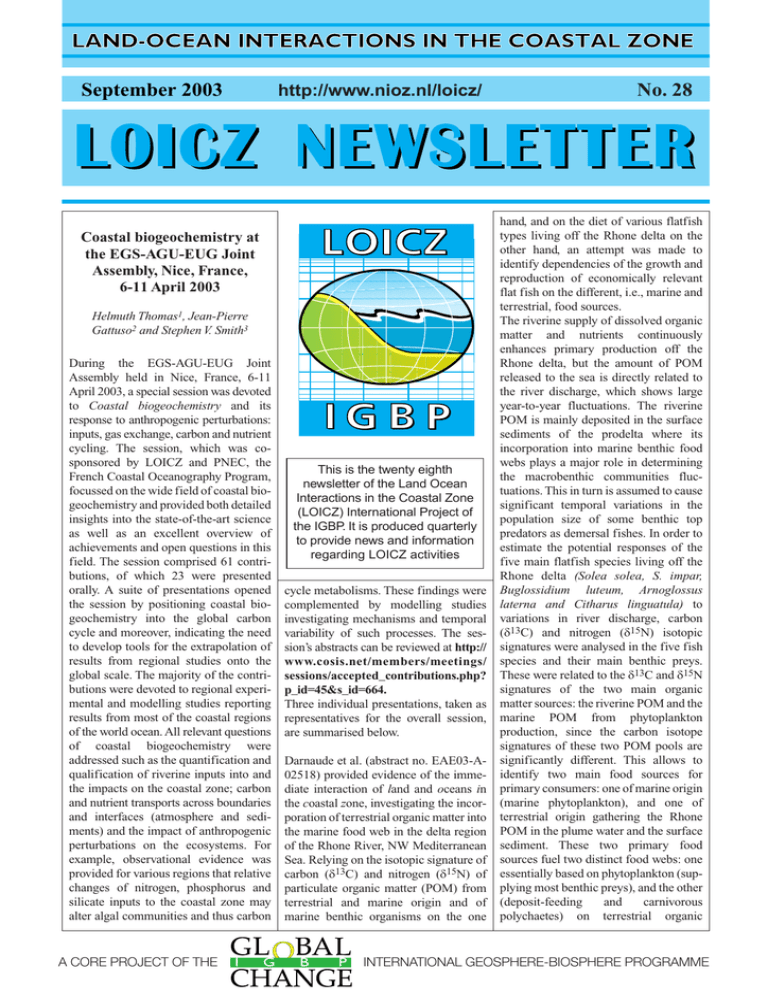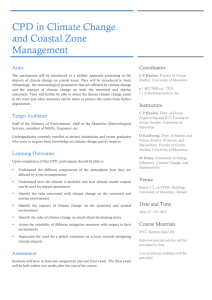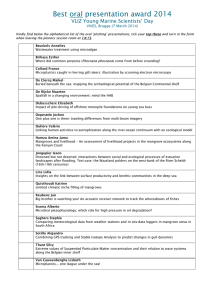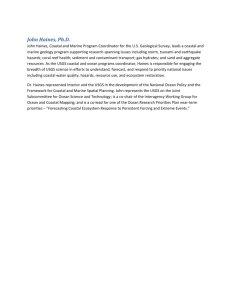September 2003 No. 28 Coastal biogeochemistry at
advertisement

September 2003 http://www.nioz.nl/loicz/ Coastal biogeochemistry at the EGS-AGU-EUG Joint Assembly, Nice, France, 6-11 April 2003 Helmuth Thomas1, Jean-Pierre Gattuso2 and Stephen V. Smith3 During the EGS-AGU-EUG Joint Assembly held in Nice, France, 6-11 April 2003, a special session was devoted to Coastal biogeochemistry and its response to anthropogenic perturbations: inputs, gas exchange, carbon and nutrient cycling. The session, which was cosponsored by LOICZ and PNEC, the French Coastal Oceanography Program, focussed on the wide field of coastal biogeochemistry and provided both detailed insights into the state-of-the-art science as well as an excellent overview of achievements and open questions in this field. The session comprised 61 contributions, of which 23 were presented orally. A suite of presentations opened the session by positioning coastal biogeochemistry into the global carbon cycle and moreover, indicating the need to develop tools for the extrapolation of results from regional studies onto the global scale. The majority of the contributions were devoted to regional experimental and modelling studies reporting results from most of the coastal regions of the world ocean. All relevant questions of coastal biogeochemistry were addressed such as the quantification and qualification of riverine inputs into and the impacts on the coastal zone; carbon and nutrient transports across boundaries and interfaces (atmosphere and sediments) and the impact of anthropogenic perturbations on the ecosystems. For example, observational evidence was provided for various regions that relative changes of nitrogen, phosphorus and silicate inputs to the coastal zone may alter algal communities and thus carbon A CORE PROJECT OF THE I G This is the twenty eighth newsletter of the Land Ocean Interactions in the Coastal Zone (LOICZ) International Project of the IGBP. It is produced quarterly to provide news and information regarding LOICZ activities cycle metabolisms. These findings were complemented by modelling studies investigating mechanisms and temporal variability of such processes. The session’s abstracts can be reviewed at http:// www.cosis.net/members/meetings/ sessions/accepted_contributions.php? p_id=45&s_id=664. Three individual presentations, taken as representatives for the overall session, are summarised below. Darnaude et al. (abstract no. EAE03-A02518) provided evidence of the immediate interaction of land and oceans in the coastal zone, investigating the incorporation of terrestrial organic matter into the marine food web in the delta region of the Rhone River, NW Mediterranean Sea. Relying on the isotopic signature of carbon (δ13C) and nitrogen (δ15N) of particulate organic matter (POM) from terrestrial and marine origin and of marine benthic organisms on the one B P No. 28 hand, and on the diet of various flatfish types living off the Rhone delta on the other hand, an attempt was made to identify dependencies of the growth and reproduction of economically relevant flat fish on the different, i.e., marine and terrestrial, food sources. The riverine supply of dissolved organic matter and nutrients continuously enhances primary production off the Rhone delta, but the amount of POM released to the sea is directly related to the river discharge, which shows large year-to-year fluctuations. The riverine POM is mainly deposited in the surface sediments of the prodelta where its incorporation into marine benthic food webs plays a major role in determining the macrobenthic communities fluctuations. This in turn is assumed to cause significant temporal variations in the population size of some benthic top predators as demersal fishes. In order to estimate the potential responses of the five main flatfish species living off the Rhone delta (Solea solea, S. impar, Buglossidium luteum, Arnoglossus laterna and Citharus linguatula) to variations in river discharge, carbon (δ13C) and nitrogen (δ15N) isotopic signatures were analysed in the five fish species and their main benthic preys. These were related to the δ13C and δ15N signatures of the two main organic matter sources: the riverine POM and the marine POM from phytoplankton production, since the carbon isotope signatures of these two POM pools are significantly different. This allows to identify two main food sources for primary consumers: one of marine origin (marine phytoplankton), and one of terrestrial origin gathering the Rhone POM in the plume water and the surface sediment. These two primary food sources fuel two distinct food webs: one essentially based on phytoplankton (supplying most benthic preys), and the other (deposit-feeding and carnivorous polychaetes) on terrestrial organic INTERNATIONAL GEOSPHERE-BIOSPHERE PROGRAMME page 2 1 2 LOICZ NEWSLETTER 3 4 5 6 7 8 9 10 11 12 -16 -17 Bl J C II -18 Cl J Cl A pagurids Si J δ 3 Si A 15 N 2 Al A holothurians -19 -20 CI amphipods pol S cumaceans bivalves juv. brachyurids copepods -21 phytopK -22 ophiurids gast. Al J macrurids gobiidae bivalves mysids ad. Bl A Ss J 1 Ss A pol C C II -23 pol DsS. -24 pol DS water POM -25 sediment CI Rhone POM -26 Marine phytoplankton-based food web -27 Terrestrial POM-based food web -28 13 δ C Figure 1 - Structure of the benthic food webs of the juveniles (J) and adults (A) of five flatfish species (Ss = Solea solea, Si = Solea impar, Bl = Buglossidium luteum, Al = Arnoglossus laterna, Cl = Citharus linguatula) studied off the Rhone river. C I = primary consumers, C II = secondary consumers, Gast. = gastropods, phytopK = phytoplankton, POM = particulate organic matter, pol = polychaetes (C = carnivorous, DS = surface deposit feeders, DsS = sub-surface deposit feeders, S = suspensivorous). Numbers in bold indicate the 3 groups of fishes individualised according to fish diet: 1 = fishes mainly feeding on CI and/or CII from the terrestrial POM-based food web; 2 = fishes principally eating CI and/or CII from the “marine” food web + variable amounts of CI and/or CII from the terrestrial POM-based food web; 3 = fishes mainly (or exclusively) feeding on “marine” CI and/or CII. matter. Accordingly, terrestrial POM enters marine benthic food webs mainly via deposit-feeding polychaetes and is transferred to fishes by the ingestion of these prey organisms or other benthic consumers that feed upon them. The results allow to separate the above 5 species into three groups (Fig. 1). The first group feeds almost exclusively on preys from the terrestrial POM based food web. The second one feeds mostly on preys coming from the marine food web but ingest small amounts of preys from the terrestrial food web. The third group feeds almost exclusively on preys from the marine phytoplankton-based food web. The exploitation of terrestrial POM is maximal for S. solea, in which both juveniles and adults essentially depend on the terrestrial POM-basedfood-web for their growth [Darnaude et al., 2003]. According to these results, the Rhone river floods should differently affect the fish population size of these 5 species, since the impact of an increase in terrestrial food availability on the fish population size will be different for the individual species and their life stages. If the continental inputs are exploited during the juvenile stage, Rhone river floods can enhance post larvae growth and survival and thus directly increase fish recruitment success. When the continental inputs are exploited at the adult stage, Rhone river floods intensity can increase both growth and condition of mature females and, through an increase in reproduction success, also have an impact on fish recruitment. In this last case, the positive impact will be delayed but it can last for several years through the successive breeding of the positively influenced adults. For the 5 species studied, the authors predict little effect of Rhone river floods on C. linguatula and S. impar populations, but a high and long lasting effect on the 3 other species. This effect should be maximal in the common sole, Solea solea, which has strong implications for the local fishery management of this high value fish [Darnaude, 2003; Salen-Picard et al., 2002]. Middelburg et al. (abstract no. EAE03A-03923) provided a global compilation of benthic organic carbon respiration in the coastal zone. Benthic coastal communities are highly diverse and include systems, in which biological entities are a structuring factor (e.g., coral reefs, mangroves, seagrass beds) as well as those, in which physical features and processes determine the landscape (e.g., rocky shores, rippled sandy sediments). Moreover, metabolism in shallow sediments depends on whether they extend within or below the euphotic zone. Benthic communities often dominate ecosystem processes and metabolism, particularly in shallow coastal waters, such as reef lagoons, and are important sites for carbon cycling and bacterial activity, and are all potentially important contributors to ecosystem respiration. Hitherto, no comprehensive evaluation of the respiration rate of benthic coastal ecosystems exists, so that their contribution to the respiration of the global ocean remains undetermined. Middelburg et al. derived a global estimate for respiration in coastal benthic communities from various regional studies covering all relevant benthic ecosystem types such as coral reefs, mangroves, salt marshes, seagrasses, and sublittoral sediments. Considering the areas covered by these ecosystems a bottom-up extrapolation of the corresponding benthic respiration rates was performed (Fig. 2). Accordingly, the respiration in benthic coastal ecosystems constitutes a major part of total coastal ocean respiration. The authors’ estimate of benthic coastal respiration of 7.5 Pg C a-1 is well above earlier estimates based on published global coastal carbon budgets (~1.8 Pg C a-1), but similar to top-down estimates of coastal respiration by heterotrophs based on the balance between net primary production and river inputs on the one hand, and sediment burial on the other (~7.5 Pg C a-1). The authors argue that page 3 LOICZ NEWSLETTER 3 Global: = 27*106 km2 = 7.5 Pg C a-1 2 25 20 15 10 1 5 0 Coral Man- Salt Sea- Macro- SediReefs groves Marshesgrasses algae ments (sublit.) Surface area [106km2] Global respiration [Pg C a-1] the excellent agreement of the bottomup and community-production top-down approaches should not be overemphasised, since both approaches are subject to serious uncertainties. 0 Figure 2 - Global and specific respiration in coastal benthic ecosystems and corresponding surface areas. The uncertainties of the bottom-up approach presented here are related to the diversity of benthic communities, aggregation problems necessary for upscaling, limited availability of data and large variability within and among ecosystems. Compared to a recent world ocean respiration estimate of 66 Pg C a-1 (del Giorgio and Duarte, 2002) the relevance of coastal seas, covering about 7% of the world ocean’s surface, in the global carbon cycle is evident, since they would contribute for approximately 11% to the world ocean respiration. Note that this estimate does not account for pelagic respiration in the coastal seas [Middelburg et al., 2004]. enclosed sea. The dominant feature is the circulation of Atlantic Ocean water through the North Sea entering at its Northwestern boundary and leaving through the Norwegian Channel. The DIC transport by this circulation constitutes the major (gross) player of the carbon budget, however without relevance for the netbudget. During the transport though the North Sea the DIC concentrations of the Atlantic Ocean water is increased. Major sources increasing the carbon contents of the Atlantic Ocean water are the Baltic Sea and rivers (providing 73% of the net carbon import to the North Sea) and the atmosphere (27%). The uptake of atmospheric CO2 by the North Sea amounts to 1.3 mol C m-2 a-1 and is maintained by the above biological pump. The short flushing time and the bottom topography prevent almost entirely the final burial of POM (3% of net export) and the entire CO2 draw-down caused by biological activity is available for export to the Atlantic Ocean (97% of net export) being the ultimate driver for the CO2 uptake. This process is supported by the above short flushing times constituting an efficient DIC removal out of the North Sea to the Atlantic Ocean. Thus, the North Sea can be seen as a bypass pump (Fig. 3a), which increases the carbon content of Atlantic Ocean while it is circulated (bypassed) through the North Sea. In comparison, the water budget of the brackish Baltic Sea is mostly controlled by riverine inputs and to a lesser extent by water exchange with the North Sea. Together both processes result in water renewal times of about 25 years. This circulation pattern and the bottom topography with several deep basins allow sedimentation of the POM produced by phytoplankton production in the euphotic zone. The annual CO2 uptake from the atmosphere is thus driven by the carbon export to the deeper basins (60%), since it replenishes the exported carbon. Only part of the CO2 taken up from the atmosphere by biological processes is available for export to the North Sea (40%). For the efficiency of the continental shelf pump in the Baltic Sea this means that despite large net carbon exports (from terrestrial sources) to the North Sea, the Baltic Sea acts as a weak continental shelf pump, since a major part of the atmospheric CO2 is transferred to the sediments, whereas in the North Sea it is almost entirely exported to the North Atlantic Ocean. A mechanistic reason for this is given by the circulation pattern, since the water is slowly transported through the Baltic Sea while seasonal recycling and sedimentation processes counteract high export rates of “atmospheric” carbon to the North Atlantic Ocean. The Baltic Sea thus serves as a collecting basin for fresh water and terrestrial carbon, which finally is injected via the Skagerrak to the North Sea (injection pump, Fig 3b), however the efficiency of the continental shelf pump here is much lower than in the North Sea, where the export is controlled by the rapid circulation and shelf-type bottom topography [Thomas et al., 2002 a, b] We will continue to address latest advancements in Coastal biogeochemistry in a special session during the 1st EGU General Assembly to be held in Nice, France, 26-30 April 2004. For further information please visit: http://www.copernicus.org/. Thomas et al. (abstract no. EAE03-A01736) established carbon budgets for the North Sea and the Baltic Sea, both located in NW Europe and connected via the Skagerrak. The carbon budgets of both seas were used to establish two different operational modes of the contia) Bypass pump b) Injection pump nental shelf pump, which is thought to transfer atmospheric CO2 to the open oceans and might be seen as a biological carbon pump. Phytoplankton produces POM, which partly settles out to the subsurface layers. Here, the POM is remineralised to dissolved inorganic carbon, (DIC) and nutrients. If these subsurface waters are circulated to the open ocean the above DIC will be exported as well. The efficiency of the continental shelf pump is controlled by biological processes as well as by the hydrography and the bottom topography of the individual coastal sea, causing different operational modes of the continental shelf pump. The carbon budget describes the North Figure 3 - Different operational modes of the continental shelf pump in the North Sea (a) and Sea as an overall autotrophic semi- the Baltic Sea (b). page 4 References: Darnaude, A.M. (2003). Apports fluviaux en zone côtière et réseaux trophiques marins benthiques: transfert de matière organique particulaire terrigène jusqu’aux poissons plats au large du Rhône. PhD Thesis, Université Aix-Marseille II: 373 p. Darnaude A.M., Salen-Picard C., Polunin N.V.C., and Harmelin-Vivien, M.L. (2003). Transfer of terrestrial organic matter into marine coastal food webs through depositivorous polychaetes elucidated by stable isotopes off the Rhone River delta (Gulf of Lions, NW Mediterranean). subm. to Oecologia. delGiorgio, P.A., and Duarte, C.M. (2002). Total respiration and the organic carbon balance of the open ocean. Nature, 420: 379-384. Middelburg, J.J., Duarte, C.M., and Gattuso, J.-P., 2004, Respiration in coastal benthic communities. pp. xxx-yyy. In P.A., del Giorgio, and P.J. le B., Williams, [eds] “Respiration in Aquatic Ecosystems”, OUP, Oxford. Salen-Picard, C., Darnaude, A.M., Arlhac, D. and Harmelin-Vivien, M.L. (2002). Fluctuations of macrobenthic populations: a link between climate variability, run-off and coastal fisheries. Oecologia, 133: 380-388. Thomas, H., Bozec, Y., deBaar, H.J.W., Elkalay, K., Frankignoulle, M., Kühn, W., Lenhart, H.J., Moll, A., Pätsch, J., Radach, G., Schiettecatte, L.S. and Borges, A. (2002b). Carbon and nutrient budgets of the North Sea and Thomas, H., Pempkowiak, J., Wulff, F. and Nagel, K. (2002a). Carbon and nutrient budgets of the Baltic Sea. Both in: L. Atkinson, K.K. Liu, R. Quinones, L. Talaue-McManus (eds.). Carbon and nutrient fluxes in global continental margins, Springer, New York, accepted. Contact details: 1 Royal Netherlands Institute for Sea Research (NIOZ) Department of Marine Chemistry and Geology P.O. Box 59, NL-1790 AB Den Burg, Texel The Netherlands, hthomas@nioz.nl 2 Laboratoire d’Océanographie de Villefranche CNRS-Université de Paris 6, B.P. 28 F-06234 Villefranche-sur-mer Cedex France, gattuso@obs-vlfr.fr 3 Department of Ecology, CICESE P.O. Box 434844 San Diego, CA 92143-4844 USA, svsmith@cicese.mx LOICZ NEWSLETTER “Catchment2Coast” linking coastal resources variability and river inputs in Africa Pedro Monteiro* and Sue Matthews Catchment2Coast is an interdisciplinary, multi-institutional modelling research project, which aims to improve the scientific understanding of the linkages between river catchments and their associated coastal environments. Supported by EU-INCO it took off in October 2002. The general objective of Catchment2 Coast is to design, implement and validate a generic integrated planning and management support system for linked catchment–coast systems in southern Africa, which can also be implemented beyond the region. This project aims to adopt a systems thinking approach as the basis for a set of diagnostic and predictive tools with explicit dynamic capabilities in respect of the aquatic environment. These capabilities will promote sustainable resource management on a whole catchment basis, specifically including the coastal zone. This project also aims to i) strengthen the regional aquatic system scientific capabilities; ii) strengthen the links between aquatic scientists and resource economists; and iii) strengthen collaboration between scientific institutions in South Africa, Mozambique and Swaziland supported by specialist interactions with European partners. The project uses as a case study the Maputo Bay-Incomati river system in Mozambique. The case study focuses on the shrimp industry, which supports the livelihood of some 3000 artisanal and semi-industrial fishers (value of catches estimated to equal US$ 3.5 million in the early 1990ies). The focus will be on the influence of runoff and material loads from the Incomati and Maputo river catchments on shrimp production in the bay. The project comprises three phases, the first of which sets up numerical platforms using existing data sets to constrain model parameters, boundary conditions and process calibration. Each of the modeling platforms will then be used to undertake sensitivity analyses to identify the most important gaps in data and understanding. Following will be a co-ordinated field measurement program, together with the platforms using scenarios defined at stakeholders’ workshop. The data collected over three seasons will be used for verification, and sensitivity analyses will be undertaken on the basic scenarios. By the end of the third phase, in which all analytical exercises thus far will be integrated, the modeling platforms will be linked. It should then be possible to identify the most important forcing factors in biophysical functioning of the catchment that affect the economics of shrimping in Maputo Bay. The complexity of the approach can be seen in the various modeling platforms involved: • River hydrology and water quality – aims to simulate the impacts of landuse changes and catchment management on hydrology and water quality; • Groundwater hydrology and water quality processes in the Incomati estuary – aims to reveal the influence of groundwater quantity and quality on the estuarine mangrove habitat; • Coastal-estuarine hydrodynamics and physical processes in Maputo Bay – aiming to capture the interaction of river flow regimes with coastal water stratification and effects on coastal resources; • Sediment and water column biogeochemistry in Maputo Bay • Mangrove ecosystem-habitat health and function in the Incomati estuary – tries to use a mangrove ecosystem model (including the nursery functions for shrimp stocks) as the receiving module for other outputs aiming to estimate shrimp production under different catchment management scenarios • Ecology of commercially exploited shrimp resources in Maputo Bay – linking above information to estimate maximum sustainable yield and recruitment; • Resource economics modeling of shrimp production in Maputo Bay – aims to estimate and express coastal ecosystem and resource goods and services variability in monetary terms • Integration of models and systems analysis – aims to provide a cost effective tool deriving from the links between the model platforms and enabling a number of scenarios that will provide information on impacts and critical flows for sustainable goods and services of the coastal ecosystem. This is the part where the policy and management interface will be located nourished by scientifically underpinned recommendations. Transferability to other tropical regions is anticipated.








